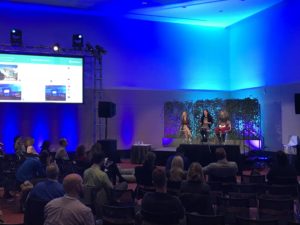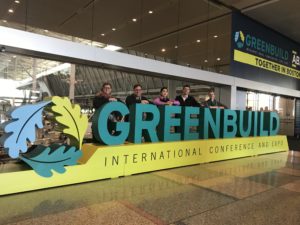

News
Recap: Terrapin at Greenbuild 2017
Georgina Davis
Share
Terrapin joined thousands of green builders in Beantown for Greenbuild 2017! While it was a little cooler than last year’s conference, we had a fantastic week of connecting and learning with this incredible community.
After a great week of education sessions and conversations, here are some trends we saw at the show:
- Technology should be treated as a tool for creating better occupant experiences: if you’re not measuring it, you’re not managing it.
- Recognizing the difference between modeled energy use and operational energy use is essential for achieving building performance goals.
- Material transparency remains a priority: just as we look to nutrition labels for our food to stay healthy, looking critically at the materials that go into our buildings is vital to creating healthy environments.
- Resiliency measures are being implemented at every scale, from individual buildings to entire cities; no matter where you are, a changing climate is redefining what our built environment will have to absorb in coming years.

Julia Africa, Amanda Sturgeon, and Catie Ryan discuss biophilic design and technology during their interactive session.
Some of the session highlights included:
Our very own Catie Ryan, alongside Amanda Sturgeon of International Living Future Institute, and Julia Africa, previously at Harvard Medical School’s Center for Health and the Global Environment, hosted an interactive session on the many emerging technologies that are transforming our understanding of biophilic design in practice. With a fitting backdrop of light projections and a green wall, they asked participants to rethink the commonly held belief that technology will always act to remove an individual from natural experiences. Instead, they explored questions of how technology can measure our responses to space, evolve the implementation of biophilic design, and expand its reach among design professionals.
For extra credit: what do you get when you mix Limonene (aromatic molecule responsible for lemon’s smell) with Ozone? For all of those who weren’t able to make it to the session, or if it only expanded your interest in this topic, check out our follow up blog post with additional resources on the many intersections of technology and biophilic design.
The team enjoyed many other sessions over the course of the conference. Our friends at COOKFOX Architects talked about their experience applying the WELL Building Standard to their new office, and the unique challenges that they faced. Bethany Borel of COOKFOOX, Charlie Marino of AKF Group, and Jessica Cooper of Delos, participated on a panel moderated by Jeffrey Rios of AKF – In Posse, discussing how wellness initiatives overlap and can sometimes seem to contradict energy efficiency measures. They highlighted the challenges and solutions that allowed each project to achieve both wellness and energy efficiency goals.
Research findings from Mariana Figuerio, Director of the Lighting Research Center (LRC) and Professor of Architecture at Rensselaer Polytechnic Institute, Dr. Esther Sternberg and Dr. Casey Lindberg from University of Arizona’s Institute on Place and Wellbeing, moderated by Kevin Kampschroer of the US General Services Administration, linked a building’s indoor environment to health impacts. The research also showed that the stress occupants experienced during work carried over to home. They discussed how circadian lighting systems, among other interventions, are important aspects of designing a healthy and productive space and can decrease stress and improve performance.
Joanna Frank of the Center for Active Design, Jeremey Alcorn of GSA, Liz York of CDC, and Ari Frankel of Alexandria Real Estate Equities discussed the research centered roots of FITWEL’s inception, along with it’s path forward. With the growing trend of health and wellness in workspaces, FITWEL needs no more justification than the demonstrable improvements to productivity and talent retention it has exhibited. And in case you weren’t in the audience to find out, FITWEL will soon extend its certification to multi-family residential buildings!
The first annual Stephen Kellert Biophilic Design Award was also presented at this year’s conference.The award was presented to the team from Khoo Teck Puat hospital in Singapore in recognition of the innovative and extensive use of biophilic design to engage all of the senses to promote healing and wellbeing. Four additional projects earned Honorable Mentions for their application of biophilic design, including Phipps Center for Sustainable Landscapes in Pennsylvania, Etsy Headquarters in New York, COOKFOX Architects Studio in New York, and Yanmar Headquarters in Japan.
Offered for the first time in 2017 through the International Living Future Institute’s Biophilic Design Initiative, the award honors Stephen’s legacy as a pioneer in articulating and applying Biophilic Design principles to the built environment.

The Terrapin team at Greenbuild 2017.
All in all, it was great to see the research and case studies that are moving biophilic design and wellness forward in so many ways. We had a great time reconnecting with colleagues, meeting new ones, and learning more about the breadth of research and work being done by the green building community.
Feature Image: Arek Olek/Flickr
Filed under:
Georgina Davis
is a research analyst at Terrapin and has a background in architecture and field research. She completed her master’s and doctoral degrees at Texas A&M University and her bachelor's at Washington University in St. Louis. Her interests include energy efficiency and occupant comfort in extreme environments and bio-inspired innovation.
Topics
- Occupant Comfort
- Materials Science
- Speaking
- LEED
- Terrapin Team
- Phoebe
- Community Development
- Greenbuild
- Technology
- Biophilic Design Interactive
- Catie Ryan
- Spanish
- Hebrew
- French
- Portuguese
- Publications
- Carbon Neutrality
- Environmental Values
- Conference
- Psychoacoustics
- Education
- Workshop
- Mass Timber
- Transit
- Carbon Strategy
- connection with natural materials
- interior design
- inspirational hero
- biophilia
- economics of biophilia
- Sustainability
- Systems Integration
- Biophilic Design
- Commercial
- Net Zero
- Resorts & Hospitality
- Energy Utilization
- Water Management
- Corporations and Institutions
- Institutional
- Ecosystem Science
- Green Guidelines
- Profitability
- Climate Resiliency
- Health & Wellbeing
- Indoor Environmental Quality
- Building Performance
- Bioinspired Innovation
- Biodiversity
- Residential
- Master Planning
- Architects and Designers
- Developers and Building Owners
- Governments and NGOs
- Urban Design
- Product Development
- Original Research
- Manufacturing
- Industrial Ecology
- Resource Management
- Sustainability Plans
- Health Care


